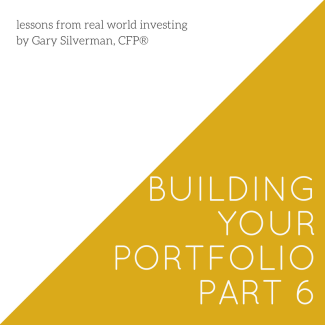
Portfolio Building: Balance based on Risk Tolerance
By Gary Silverman, CFP®
Last week was a bit of a tease. We began getting into building an investment portfolio. And then we stopped before I told you exactly what to put in it. Don’t worry…in future columns I’ll have recommendations about building a portfolio that’s incredibly easy to manage. Don’t stop reading this section though. You’ll want to know these basics to understand how that easy portfolio works.
As I stated last week, I think you should begin by building a base portfolio that is geared toward maximum growth without taking stupid risks. Then I discussed how, during market extremes, even the most perfect portfolio can often exceed what my clients, or in this case you, can stand.
What we are trying to adjust for is your risk tolerance (we’ve discussed that in this column often). Once we know our client’s risk tolerance, we compare it to the risk we anticipate from our base portfolio. If we do not think they can stand that amount of risk (and most can’t), corporate or government investment grade bonds are added to the portfolio to reduce the down-side volatility. You should do the same.
The key here isn’t the specific securities you use to water down the risk of the portfolio, but that you add something to it to bring down that risk. We typically use bond funds. You might consider CDs from a bank, a fixed annuity, or a money market fund instead.
As you might expect, by lowering the risk of a portfolio in this way, we also lower the returns. This is a good trade-off. Why? Because investors will do stupid things in time of market turmoil when they feel their portfolios have been dropping too far or for too long.
Remember: in times of panic, fear overrides sense and chaos results.
By limiting a portfolio’s risk in line with your ability to tolerate it, you can reduce or eliminate the chance that you will “freak” and sell out during a market bottom. Preventing that possibility is well worth a slight reduction in expected returns.
Part of risk moderation is considering your cash flow needs. Depending on their circumstances, the portfolio’s recent performance, and a bit of judgment, we keep between six-months and four-years of a client’s cash needs in ultra-low risk investments.
The reason for this is simple: Murphy’s Law. This law in my experience accurately states that whatever can go wrong, will. The first corollary to the law states that this will happen at the worst possible time. Applied to cash flow, this means that the markets will be stellar until right before you need to make a withdrawal to buy something; then they crash.
This then leaves you in a hard place. If you don’t cash out some of the investments, you can’t buy what you were planning. If you do cash out your investments in the doldrums of a bear market, temporary losses become permanent.
Either choice you make is a bad one. But keep enough money out of the way of a crash and you can be sure you’ll have it when you need it.
Gary Silverman, CFP® is the founder of Personal Money Planning, LLC, a Wichita Falls retirement planning and investment management firm and author of Real World Investing

